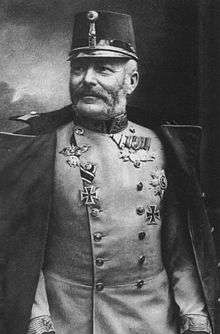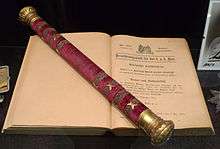Archduke Friedrich, Duke of Teschen
| Archduke Friedrich | |
|---|---|
 | |
| Duke of Teschen | |
| Reign | 1895–1918 |
| Predecessor | Albrecht |
| Born |
4 June 1856 Gross-Seelowitz, Moravia |
| Died |
30 December 1936 (aged 80) Magyaróvár, Hungary |
| Burial | Imperial Crypt |
| Spouse | Princess Isabella of Croÿ |
| Issue |
Maria Christina, Hereditary Princess of Salm-Salm Maria Anna, Princess Elias of Bourbon-Parma Maria Henrietta, Princess Gottfried of Hohenlohe-Waldenburg-Schillingfurst Archduchess Natalie Maria Archduchess Stephanie Maria Isabelle Archduchess Gabriele Maria Theresia Isabella, Princess Georg of Bavaria Maria Alice, Baroness von Bassenheim Archduke Albrecht Franz, Duke of Teschen |
| House | Habsburg-Lorraine |
| Father | Archduke Karl Ferdinand of Austria |
| Mother | Archduchess Elisabeth Franziska of Austria |
| Religion | Roman Catholicism |
Archduke Friedrich, Duke of Teschen (Friedrich Maria Albrecht Wilhelm Karl; 4 June 1856 – 30 December 1936) was a member of the House of Habsburg and the Supreme Commander of the Austro-Hungarian Army during World War I.
Early life
Friedrich was born at the castle Gross-Seelowitz (now Židlochovice, near Brno in Moravia) the son of Karl Ferdinand, Archduke of Austria and his wife Archduchess Elisabeth Franziska of Austria.
His siblings included Queen Maria Cristina of Spain, Archduke Charles Stephen of Austria, a candidate for the Kingdom of Poland, and Archduke Eugen of Austria, and Austrian officer.
When Friedrich's uncle Archduke Albert, Duke of Teschen died in 1895, he and his brothers each inherited large estates. Friedrich owned properties at Ungarisch-Altenburg (now Mosonmagyaróvár in Hungary), Belleje, Saybusch (now Żywiec in Poland), Seelowitz (now Židlochovice) and Frýdek in the Czech Republic, and Pressburg (now Bratislava in Slovakia). His Vienna residence, the Palais-Albrecht, housed the Albertina art collection which he owned.
Marriage
On 8 October 1878 Friedrich married at Château L'Hermitage in Belgium, Princess Isabella of Croÿ (1856–1931), daughter of Rudolf, Duke of Croÿ, and his wife Princess Natalie of Ligne. They had nine children together.
- Maria Christina, Archduchess of Austria-Teschen (1879–1962), married Prince Manuel of Salm-Salm
- Maria Anna, Archduchess of Austria-Teschen (1882–1940), married Elias, Duke of Parma
- Maria Henrietta, Archduchess of Austria-Teschen (1883–1956), married Prince Gottfried of Hohenlohe-Waldenburg-Schillingfurst
- Natalie, Archduchess of Austria-Teschen (1884–1898)
- Stephanie, Archduchess of Austria-Teschen (1886–1890)
- Gabriele, Archduchess of Austria-Teschen (1887–1954)
- Isabella, Archduchess of Austria-Teschen (1887–1973), married Prince Georg of Bavaria
- Maria Alice, Archduchess of Austria-Teschen (1893–1962), married Baron Friedrich Waldbott von Bassenheim
- Albrecht Franz, Archduke of Austria, Duke of Teschen (1897–1955)
Military career

Like most of the princes of the ruling house, Friedrich adopted a military career, and served creditably for many years as commandant of the V. (Pressburg) Corps. Subsequently, commander-in-chief of the Austrian Landwehr (militia) and army inspector, he became, after the murder of the heir to the throne, Archduke Franz Ferdinand, inspector-general of the Austro-Hungarian Army.[1]
In World War I, he was —from the dynastic point of view —as grandson of the victor of Aspern, Archduke Charles, and as nephew of the victor of Custoza, Archduke Albert, the predestined head of the armed forces of Austria-Hungary; and on 11 July 1914 Friedrich was appointed supreme commander of the Austro-Hungarian Army by Emperor Franz Joseph I. He thought it his duty to accept this heavy responsibility, but, modestly estimating his own powers, left the actual exercise of the command to his chief-of-staff, Franz Graf Conrad von Hötzendorf. In the performance of ceremonial duties, and as mediator for the settlement of the conflicting demands of the military, civil and allied elements, his services were undeniable.[1] He was promoted to the rank of Generalfeldmarschall on 8 December 1914. In the spring of 1917 Emperor Charles himself took over the supreme command; the Archduke, although the Emperor's representative, no longer appeared in the foreground. Friedrich remained supreme commander until February 1917 when Emperor Charles I decided to take the office himself.
Retirement and death
After World War I the governments of Austria and Czechoslovakia confiscated all of Friedrich's properties within their borders. These included his palace in Vienna and his art collection. He retained his properties in Hungary however. In 1929 he won a court case requiring compensation from the Czechoslovak government.[2]
Friedrich died at Ungarisch-Altenburg (Magyaróvár, now Mosonmagyaróvár) in 1936. His death was the biggest royal event for Hungary since the coronation of King Karl in 1916. The funeral and burial in the Pfarrkirche in Mosonmagyaróvár was attended by his nephew, the exiled King of Spain; by numerous archdukes; by all the surviving Austro-Hungarian field marshals; by personal representatives of Hitler; by members of the House of Savoy; by the diplomatic corps; by a son of exiled German Kaiser Wilhelm; by representatives of the governments of Germany, Italy and Austria, and by Hungary's Regent, Miklós Horthy and his wife. There were members of the Hungarian government and delegates of the German and Austrian in attendance as well. Entire battalions of the Hungarian army were present to pay their last respects to their former Supreme Commander.
Ancestry
Decorations and awards
- Austrian honours
- Knight of the Order of the Golden Fleece
- Knight Grand Cross of the Royal Order of Saint Stephen of Hungary
- Military Merit Cross, 1st class with war decoration
- Gold Military Merit Medal ("Signum Laudis")
- Foreign honours
- Knight of the Order of St. Andrew (Russian Empire)
- Knight of the Imperial Order of St. Alexander Nevsky (Russian Empire)
- Order of St. Anna, 1st class (Russian Empire)
- Grand Cross of the Military Order of Max Joseph (Bavaria)
- Knight of the Order of the White Eagle (Russia)
- Knight Grand Cross of the Order of the Bath (United Kingdom)
- Commander 1st Class of the Military Order of St. Henry
- Iron Cross
- Military Merit Cross, 1st class (Grand Duchy of Mecklenburg-Schwerin)
- Knight of the Order of the Elephant (Denmark)
Notes
- 1 2
 One or more of the preceding sentences incorporates text from a publication now in the public domain: Chisholm, Hugh, ed. (1922). "Frederick, Archduke of Austria". Encyclopædia Britannica (12th ed.). London & New York.
One or more of the preceding sentences incorporates text from a publication now in the public domain: Chisholm, Hugh, ed. (1922). "Frederick, Archduke of Austria". Encyclopædia Britannica (12th ed.). London & New York. - ↑ "Papa Friedrich Preferred", Time Magazine ( 18 February 1929)
References
- Heiszler, Vilmos. Photo Habsburg: Frederick Habsburg and his Family. Budapest: Corvina, 1989.
- Jewison, Glenn, and Jörg C. Steiner. "Erzherzog Friedrich" (Austro-Hungarian Land Forces 1848–1918).
- Palmer, Alan. Twilight of the Habsburgs: The Life and Times of Emperor Francis Joseph. Atlantic Monthly Press; 1st Pbk. Ed edition.
- Stefanovics, Glenn W. "Friedrich Maria Albrecht Wilhelm Karl von Österreich-Toskana, Herzog von Teschen"
External links
![]() Media related to Archduke Friedrich, Duke of Teschen at Wikimedia Commons
Media related to Archduke Friedrich, Duke of Teschen at Wikimedia Commons
| Archduke Friedrich, Duke of Teschen Cadet branch of the House of Lorraine Born: 4 June 1856 Died: 30 December 1936 | ||
| Regnal titles | ||
|---|---|---|
| Preceded by Archduke Albert |
Duke of Teschen 1895–1918 |
Succeeded by Monarchy abolished |
| Titles in pretence | ||
| Loss of title Monarchy abolished |
— TITULAR — Duke of Teschen 1918–1936 |
Succeeded by Archduke Albrecht Franz |